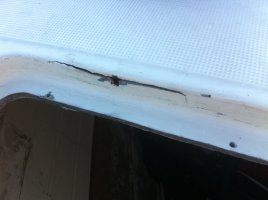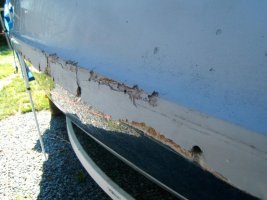The hole into which the latch on my chain locker door rests was cracked open. I took a Dremel tool and cut away the outside and have started digging out (balsa?) wood. At first the stuff that came out was black. More digging brought yellow wood but you could squeeze water out of it. Digging beyond that brings out wood that is lighter in color and does not yield water when squeezed but is obviously still moist.
I know I'm supposed to keep digging until I get to dry wood but the farther back I go the more difficult it will be to pump resin back into the void and fill it completely without drilling holes into the topside and injecting it with a syringe. Plus, I don't know how far back I'm going to have to go.
Soooooo………The questions are……
How much moisture could I safely leave in there? I'm certain it is virtually all fresh water.
If the answer is "zero" then could anyone suggest an effective means of driving out the remaining moisture? I was thinking about putting a phalanx of ceramic heaters beneath it and/or covering it with heating pads.
Thanks in advance. You guys are always a big help.
Ed
"Kinnaree"
1991 E-34


I know I'm supposed to keep digging until I get to dry wood but the farther back I go the more difficult it will be to pump resin back into the void and fill it completely without drilling holes into the topside and injecting it with a syringe. Plus, I don't know how far back I'm going to have to go.
Soooooo………The questions are……
How much moisture could I safely leave in there? I'm certain it is virtually all fresh water.
If the answer is "zero" then could anyone suggest an effective means of driving out the remaining moisture? I was thinking about putting a phalanx of ceramic heaters beneath it and/or covering it with heating pads.
Thanks in advance. You guys are always a big help.
Ed
"Kinnaree"
1991 E-34


Last edited:


